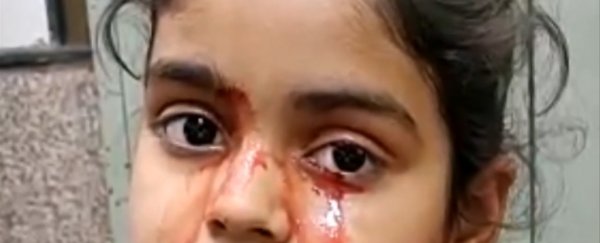The sight of blood spontaneously pouring from a child's eyes would shock just about any parent. For one unnamed mother in India, discovering crimson streaks running down her daughter's face was a truly horrifying experience.
A recent case study by opthamologists from the All India Institute of Medical Sciences in New Delhi details the strange and incredibly rare medical phenomenon known as haemolacria in an 11-year-old girl.
According to the girl's mother, the bouts of bloody tears had been a daily occurrence over the previous week. Without pain or intense emotion, red streaks would suddenly trickle down the child's cheeks for several minutes, two to three times each day.
"I am scared about my daughter's health," the mother is reported to have told staff. "The blood coming from her eyes is horrifying. I hope there will not be any similar episodes in future."
The clinic ran a battery of tests to find the cause, coming up empty handed each time. The patient had no history of trauma or illness. Her tear glands appeared to be intact, her blood results were clear, and other than blood cells, the fluids being emitted from her tear ducts weren't unusual in any way.
Experts at the clinic could not come up with a single clue that might help them understand the case. Still, while under observation for the next few days, the child would continue to weep bloody tears.
As rare as cases like hers are, the shocking nature of haemolacria means there's no shortage of examples of the condition through medical history.
The Greek physician Aëtius of Amida might have been referring to something similar when he described childhood diseases that involved blood leaking from the corner of the eye. Other historical medical writers such as Antonio Brassavola and Rembertus Dodoens have also allegedly reported cases associated with menstruation in adolescent women.
In more recent times, reports of bloody tears in young women have drawn a mix of both medical interest and media sensationalism.
Ten years ago, National Geographic documented a similar case in a 14-year-old Indian girl named Twinkle Dwivedi, whose condition was famously questioned as a hoax at the hands of the girl's mother.
In 2019, a medical study described a case of haemolacria similar to this recent one, in a 16-year-old girl admitted to a hospital in Bangladesh.
It's possible that in at least some cases, hormones could be playing a role. A 1991 study that tested for hidden or 'occult' blood in the tears of 125 healthy volunteers found traces of blood in nearly one fifth of them, most often during their menstrual cycle.
But the condition is by no means restricted to one gender; just two years ago, a middle-aged man showed up in an Italian emergency department with blood gushing from his eyes.
In that case, a possible cause was found: he appeared to have conjunctival hyperaemia, a slight excess of blood in the membrane covering his eyeball.
There are plenty of other health conditions that could also help explain some incidences of the bloody phenomenon, such as the blood clotting disease haemophilia, or the blood vessel disorder Osler-Weber-Rendu syndrome.
Some medications can also cause blood to leak into tear glands; and of course, there is always the possibility of some kind of trickery.
Unfortunately, in the case of this poor 11-year-old and her upset mother, none of these explanations offer peace of mind. Her diagnosis of haemolacria remains 'idiopathic' (of unknown cause), which more or less means 'one of those strange things'.
The good news is there's no reason to think the tears of blood are a cause for ongoing concern; in fact, they could easily vanish just as strangely and suddenly as they started.
This case study was published in BMJ Case Reports.
